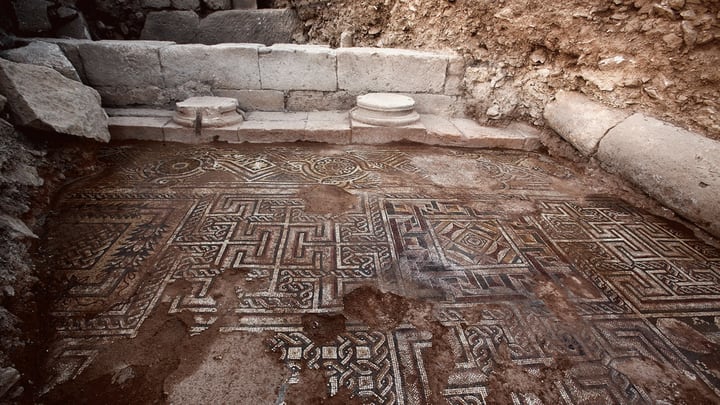Archaeologists Unearth Roman Syrian Mosaic in Turkey

The devastating civil war in Syria has made archaeological expeditions in that country impossible, which is especially problematic considering the wholescale looting and destruction of ancient sites like Palmyra by ISIL and other groups. But across the border in Turkey, in a region where tens of thousands of Syrians are living in refugee camps, German archaeologists have unearthed a stunning mosaic at the site of a former Roman-Syrian city that was built thousands of years before today's geopolitical borders were put into place.
The ancient city of Doliche—modern Dülük—is located on the outskirts of what is today Gaziantep, about 50 miles north of the Syrian-Turkish border. It was once part of the Roman province of Syria. Archaeologists from the University of Münster discovered the mosaic just this year, in their first year of excavation at the site. The mosaic was unearthed in a building complex with a center courtyard enclosed by columns that originally covered more than 100 square meters.
“Because of its size and the strict, well-composed sequence of delicate geometric patterns, the mosaic is one of the most beautiful examples of late antique mosaic art in the region,” University of Münster archaeologist Michael Blömer said in a press statement. They suspect the complex was once a wealthy villa.
As the excavation expands next year to public areas of the ancient town, “we hope to obtain a reliable picture of a northern Syrian city from the Hellenistic era to the age of the Crusaders," Blömer said.
Nearby, their colleagues have made new finds at a related site they've excavated for the past 15 years: the sanctuary of Jupiter Dolichenus, a Roman mystery cult god. Later, the Christian abbey St. Solomon was constructed on the site. The team has found architectural remnants and artifacts from both eras—and even earlier.
Some artifacts date as far back as the 9th century BCE, making the sanctuary much older than they originally estimated. The discovery this year of a lovely, high-quality bronze stag dating to the early 1st millennium BCE further confirms this more ancient occupation.
While Doliche was a minor city, it's become quite valuable to archaeologists in recent years, since it's one of the few Roman-Syrian sites that isn't being actively looted or destroyed—or that hasn't become simply too dangerous to be near. Important ancient cities like Apamea, home to more than 115,000 people during the 1st century CE and recently devastated by looters, are now completely off-limits, being within Syria's borders. “The situation today at the site of Apamea, one of the most important ancient cities of Syria, is particularly bad,” the University of Münster's Englebert Winter said. “Illicit excavations, clearly visible in satellite imagery, have destroyed the entire urban area. It remains doubtful if research there will ever be possible again."
All photos: Peter Jülich || University of Münster